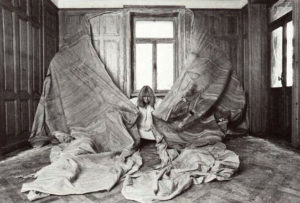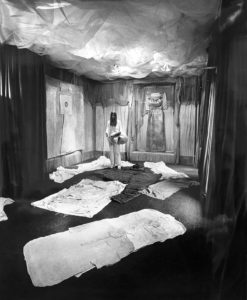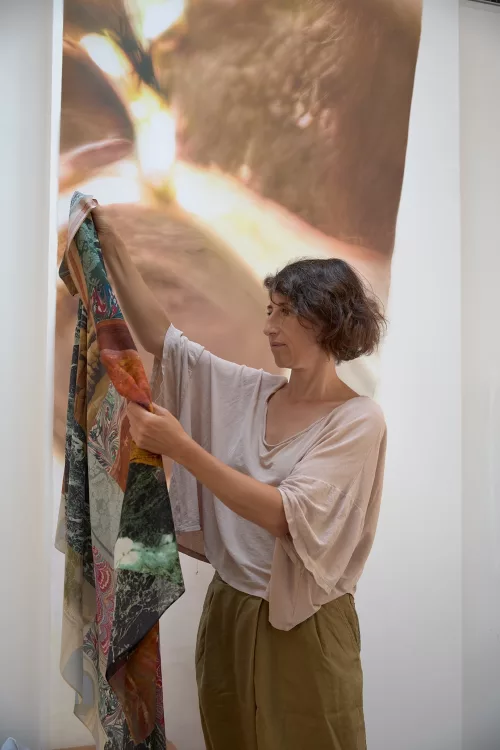Research
Swiss artist Heidi Bucher (1926-1993), forgotten after her death, was able to render architecture organic through a body of work connected to her past and to her history.
A maieutics of intimacy emerged, in which H. Bucher used pearled latex to take the imprint of elements of furniture or walls. This process of coating and skinning was established in 1973 and bore witness to the genealogical and/or political density of the locations that she invested. The singularity of her work questions at once body and architecture, the durable and the ephemeral, performance and soft sculpture, memory and filiation.
Since 2004, thanks to the retrospective dedicated to the artist at the Migros Museum für Gegenwartskunst, in Zurich, her art practice was once again integrated within exhibition visits. The most recent, Women House, organised at the Monnaie de Paris in 2017-2018, explored the relationship between the feminine and domestic space. If H. Bucher’s body of work is still in the spotlight of museums today, it is because she enables us to reflect on the role of women within creative practice.
The thesis Heidi Bucher et ses Raumhaut (« peaux de pièce ») des années 1970 à 1990: la chambre comme empreinte de soi et de sa généalogie au cœur du patriarcat [Heidi Bucher and her Raumhaut (“room skins”) from the 1970s to 1990: the Bedroom as an Imprint of the Self and One’s Genealogy Within the Heart of the Patriarchy] aims to identify the actions of the artist’s sensitive expression, analysed in various forms, between the “eccentric abstraction” theorised by Lucy Lippard in 1966 and the personal mythologies questioning society through everyday life. The technique of moulding by way of the gaze and liquid latex enabled H. Bucher to produce a reading of the architectural themes of the 19th century and to “stamp”1 private lives, the psyche, and the incommunicable. More than a mere medium, the bedroom is the receptacle of intimacy, representations, and self-affirmations.

Heidi Bucher, Ablösen der Haut II – Herrenzimmer, 1979, © Photo: Hans Peter Siffert

Heidi Bucher in her studio, Zurich, 1976, © Rights reserved
The Herrenzimmer (cabinet or fumoir) from 1979 is the cornerstone of this exploration of the artist’s work not only because it was studied as her masterpiece over the years, but also because it offers keys to understanding the symbolic power of the artist’s œuvre. The creative gesture via skinning, the staging of suspended works, the references to chrysalises, and to clothing, all shed light on the many-layered depths of her memory and history. This cabinet alone evokes her detachment from paternal authoritarianism and a new relationship to her childhood home.
Resonating with Virginia Woolf’s seminal work A Room of One’s Own (1929), this work associates the rejection of patriarchy with the idea of a reappropriation of domestic space and creativity by women, so as to read the imprints that they leave in the walls.
Master 2 research thesis directed by Elvan Zabunyan and Baptiste Brun and defended by Adélie Le Guen, on 23 October 2017, at Université Rennes 2.
“To say that you obtain a form through pressure on or in something,” in Didi-Huberman Georges, La Ressemblance par contact. Archéologie, anachronisme et modernité de l’empreinte (Paris: Les Éditions de Minuit, 2008). Our translation.
Adélie Le Guen, "The Bedrooms of Heidi Bucher: Between Poetic and Post-1968 Social Influences." In Archives of Women Artists, Research and Exhibitions magazine, . URL : https://awarewomenartists.com/en/magazine/les-chambres-de-heidi-bucher-entre-empreinte-poetique-et-empreinte-sociale-post-68/. Accessed 13 July 2025







